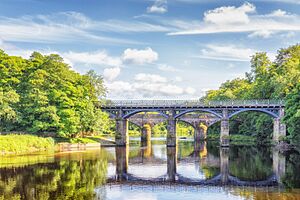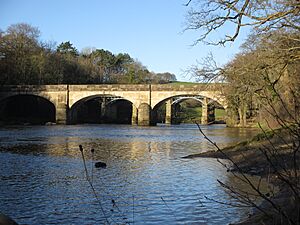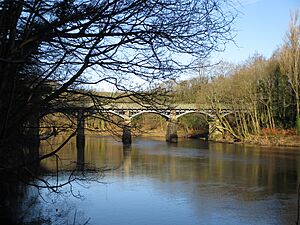Crook o' Lune facts for kids
The Crook o' Lune is a beautiful horseshoe-shaped bend in the River Lune. You can find it about three miles northeast of Lancaster, in Lancashire, England. Here, the river gently winds through green fields and small hills, then flows into a wooded valley.
This spot has been famous for a long time because of its amazing views. You can look east up the Lune valley and see Hornby Castle. On a clear day, you might even spot Ingleborough and other hills from the Pennines far away! Many famous artists and writers, like J. M. W. Turner, Thomas Gray, and William Wordsworth, loved this place and wrote about its beauty. Some even say it's as beautiful as the Lake District!
The Crook o' Lune is part of the Forest of Bowland Area of Outstanding Natural Beauty and the Lune Millennium Park, which means it's a special place that's protected. Three bridges cross the river here: two old railway bridges (now for walkers and cyclists) and one road bridge. All of them are special historic buildings.
Just so you know, there's another place called Crook of Lune near Lowgill in Cumbria. It's a similar bend in the same river, but don't get them mixed up!
Contents
Exploring Crook o' Lune
The Crook o' Lune is a super popular spot for people who love to walk. There are public footpaths that follow both sides of the River Lune, going both upstream and downstream.
You can also cycle here on the Lune Millennium Cycleway. This path follows an old railway line and connects the Crook o' Lune to Lancaster in the southwest and Caton to the east. There's even a special path that leads up the south bank to a great viewpoint called Gray's Seat.
When you visit, you'll find handy facilities like a car park, a cafe, a picnic area, and public toilets. There's also a hotel and a caravan park nearby if you want to stay longer. Getting here is easy too, as the A683 road connects it to Lancaster and the M6.
Amazing Bridges
Two impressive bridges, called viaducts, cross the Crook o' Lune. They were built for the "Little" North Western Railway. The West Viaduct has six arches, and the East Viaduct has five. Both are now protected historic buildings.
These viaducts were built in 1849, possibly designed by Edmund Sharpe. At first, they only carried one railway track. In 1882, a second track was added. The railway line closed in 1967 as part of the Beeching cuts, which closed many railway lines across the UK. Since then, these old railway bridges have been turned into long paths for walking and cycling. The West Viaduct was repaired in 2005, and the East Viaduct in 2013, so they are safe for everyone to enjoy today.
The river is also crossed by a road bridge called the Caton Lune Bridge, which is also a historic building. The very first road bridge here was built in 1806. People called it the Penny Bridge because you had to pay a toll (a penny!) to cross it. It was made of stone and had three arches. However, it wasn't as strong as people hoped, and by 1880, it needed to be replaced. The current Caton Lune Bridge was finished in 1883. It's made of sandstone and also has three arches.
Nature and Wildlife
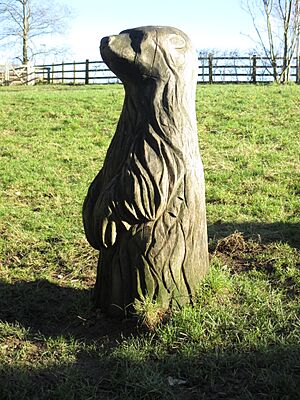
The western parts of the Crook o' Lune are very green, with lots of trees on both sides of the river. Recently, even more trees have been planted in a "memorial forest" at Hermitage Field.
There's also an area set aside to create a wildflower meadow. You can find native trees like oak, wild cherry, hawthorn, and holly growing here. In spring, you might see beautiful bluebells and wild garlic. However, there are also some plants that aren't native to the area, like the colourful Himalayan balsam and the very fast-growing Japanese knotweed.
The Crook o' Lune is famous for fly fishing. The river is home to fish like brown trout, rainbow trout, and salmon. You might also be lucky enough to spot otters playing in the water, and it's said to be a great place to see bright blue kingfishers too!
Old Stories and Legends
Near the south bank of the Crook o' Lune, inside a private park called Quernmore Park, there's a very old well called Queen's Well. Local stories connect this well to different queens.
Some say King Edward I's wife, Eleanor of Castile, visited it. Others believe Mary, Queen of Scots, rested there while traveling to or from Bolton Castle, where she was held prisoner. This story even inspired a poem called "Queen Marie's Well" by Henry Chorley. A third queen, Elizabeth I, is also said to have visited the Crook o' Lune during one of her royal trips. The story goes that she declared the view here was one of the most beautiful in her entire kingdom!
Famous Visitors and Art
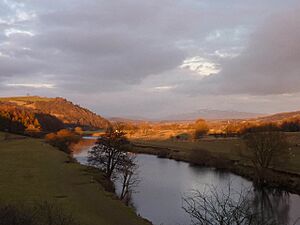
The natural beauty of the Crook o' Lune has been admired by many famous people over the centuries. In 1769, the writer Thomas Gray described the area as a "rich and beautiful enclosed country" with the "river Lune winding in a deep valley." His friend, the poet William Mason, also wrote about the amazing view, mentioning Ingleborough in the background and the river winding through the valley.
In 1779, a young William Wilberforce, who later became famous for fighting against slavery, wrote in his diary that the view at Crook o' Lune was "the finest of the kind I ever beheld." He described a valley with villages and grand houses, the Lune river lined with woods, and Ingleborough in the distance. He thought it was worth staying a day in Lancaster just to see this view!
Around 1817 or 1818, the famous artist J. M. W. Turner painted a beautiful watercolour called Crook of Lune, looking towards Hornby Castle. He captured the view from the same spot Thomas Gray had used, but he changed some details to make the painting even more artistic. This painting has been called "one of the grandest and loveliest panoramas that Turner ever created."
The Crook o' Lune was also painted by other artists like S. J. "Lamorna" Birch, Reginald Aspinwall, Arthur Henry Knighton-Hammond, and William Hoggatt. Travel books from the 18th and 19th centuries, such as those by Thomas West, Ann Radcliffe, and William Wordsworth, also helped make the Crook o' Lune a popular place for tourists to visit.


